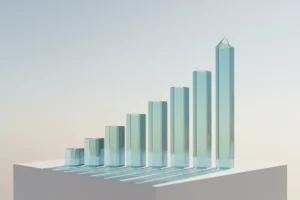Sustainable growth is a concept that combines economic development with environmental preservation, seeking a balance between the need for growth and the protection of natural resources. In a world where the demand for economic development is growing, the question that arises is: Is it possible to achieve robust economic growth without compromising the environment? To answer this question, it is essential to understand the nuances of sustainable growth and the challenges it presents today. Tools like Greenly are helping businesses and organizations track and reduce their environmental footprint, making sustainability more measurable and actionable in practice.
Therefore, the key question is: Should economic growth be limited in the name of preserving natural resources? The issue of limiting economic growth in the name of preserving natural resources is highly controversial and involves complex considerations. Here are the main perspectives on this issue:
Arguments for Limiting Economic Growth
Environmental Sustainability: Those who advocate limiting economic growth argue that the current model of infinite growth is unsustainable on a planet with finite resources. Continuing to expand the economy without considering ecological limits leads to ecosystem degradation, biodiversity loss, and climate change. To ensure the survival of future generations, it is necessary to rethink growth and focus on an economy that respects natural limits. Businesses can also integrate methods such as carbon accounting to measure, report, and reduce emissions, ensuring that progress is aligned with climate goals.
Long-Term Human Well-Being: Preserving natural resources is essential for long-term human well-being. Environmental degradation resulting from unbridled economic growth can cause water, food, and energy shortages, as well as trigger natural disasters. Limiting growth can be a way to avoid these catastrophic scenarios and ensure that everyone’s basic needs are met in the future.
Steady-State Economy: Some economists advocate the idea of a steady-state economy, where the goal is to maintain economic stability rather than continuous growth. In this model, the focus is on distributing wealth more equitably and improving the quality of life, rather than relentlessly increasing GDP.
Arguments Against Limiting Economic Growth
Poverty Reduction and Improvement in Quality of Life: Economic growth has historically been associated with poverty reduction, increased life expectancy, and improved quality of life. Therefore, limiting growth prevents developing countries from achieving the levels of well-being enjoyed by developed countries, perpetuating poverty and global inequalities.
Technological Innovation and Efficiency: Critics of growth constraints argue that technological advancement and innovation can solve environmental problems without restricting economic growth. Clean technologies, renewable energy, and sustainable agricultural practices allow the economy to continue growing while reducing environmental impact.
Flexibility and Adaptation: Economies that continue to grow are generally more flexible and adaptable to new realities, including environmental challenges. Therefore, limiting growth can stagnate the economy, hindering its ability to respond to crises and implement innovative solutions to environmental problems.
Sustainable Growth: Theories
Several economic theories address sustainable growth. Ecological Economics, for example, proposes an integration between economics and ecology, emphasizing that economic growth must respect the planet’s limits. The Circular Economy, on the other hand, suggests a model where resources are continually recycled and reused, minimizing waste and the exploitation of new resources.
Differences Between Economic Growth and Sustainable Growth
It’s important to distinguish between economic growth and sustainable growth. While economic growth refers to increased production and consumption, sustainable development encompasses broader progress, including social, economic, and environmental aspects. The goal is to improve the quality of life without compromising future resources.
Principles of Sustainable Growth
One of the pillars of sustainable growth is the efficient use of natural resources. This involves maximizing the productivity of available resources while minimizing negative impacts on the environment. Thus, green technologies, such as efficient irrigation systems and precision agricultural production, are examples of practices that promote sustainability.
Circular Economy and Waste Reduction
The Circular Economy is another essential principle, where waste from one process is reintegrated as resources in another. This model reduces the need for new resource extraction, extends the lifespan of materials, and reduces the amount of waste sent to landfills.
Renewable Energy and Clean Technologies
Investing in renewable energy sources and clean technologies is essential for sustainable growth. Energy sources such as solar, wind, and biomass offer alternatives to fossil fuels, reducing greenhouse gas emissions and dependence on non-renewable resources.
Corporate Social Responsibility
Corporate social responsibility (CSR) plays a crucial role in sustainable growth. Companies committed to CSR adopt practices that not only focus on profit but also consider the social and environmental impact of their operations. This includes everything from reducing GHG emissions to supporting local communities. ESG also plays a similar role in this process.
Considerations of Commitment to Sustainable Growth
An intermediate approach could involve:
- Green Growth: Promoting economic growth that is compatible with environmental preservation. This may include transitioning to renewable energy, promoting energy efficiency, and adopting sustainable production and consumption practices.
- Reforming Growth Indicators: Rethinking what economic growth means, moving beyond GDP as the primary measure of progress. Indicators that take into account social well-being, environmental sustainability, and wealth distribution can provide a more holistic view of economic development.
The Role of Innovation in Sustainable Growth
Technological innovation is essential for sustainable growth, even if some of it requires extracting more natural resources. However, green technologies, such as carbon capture and storage (CCS) and water desalination, can help reduce the environmental impacts of economic growth and do not contribute to the cycle of resource consumption. On the contrary, these technologies repair the consequences of consumerism.
Sustainable Startups and New Business Models
Sustainable startups are revolutionizing traditional business models. Companies that adopt circular economy practices, such as reusing materials or offering services instead of products, are demonstrating that it is possible to grow profitably and sustainably.
Digitalization and Sustainable Growth
On the other hand, digitalization is also transforming sustainability. Data-driven solutions, such as precision agriculture and smart cities, enable more efficient use of resources, thus reducing waste and optimizing processes in various industries. Alongside these tools, blockchain is increasingly being tested for sustainability reporting and supply-chain traceability, adding a layer of accountability as economies pursue green growth.
Impact of Renewable Energy on Sustainable Growth
Solar and Wind Energy as Viable Solutions: Solar and wind energy are among the most viable and affordable renewable energy sources. These technologies have become increasingly cost-competitive, providing a clean and sustainable alternative to fossil fuels.
Biofuels and Alternative Energies: Biofuels, particularly ethanol and biodiesel, offer an alternative to fossil fuels, especially in the transportation sector. Using agricultural and forestry residues to produce energy helps reduce dependence on non-renewable resources and reduces greenhouse gas emissions.
Energy Transition and Economic Impacts: The transition to renewable energy has significant economic impacts. Although it requires significant initial investment, long-term benefits include reduced operating costs, reduced energy price volatility, and the creation of green jobs.
Infrastructure Challenges for Renewable Energy: One of the main challenges for the expansion of renewable energy is infrastructure. Integrating these energy sources into the electricity grid requires investment in technology and storage systems, as well as the modernization of existing infrastructure.













